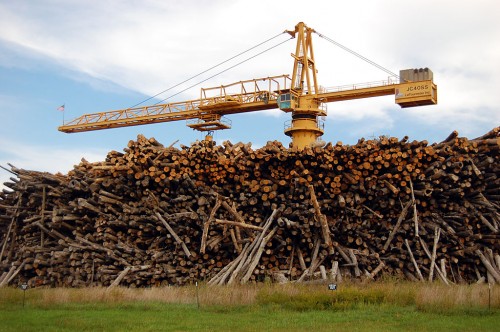 Brother Mark wanted to see the Eisleben Lutheran Church in Scott City after we had an excellent lunch at The Piebird Cafe in Fruitland to celebrate Mother’s 90th birthday. After seeing the church, Mother said she thought the road we were on would take us to the river, so we went exploring. When we got to SEMO Port, we came upon a huge mound of logs with a big, yellow LeTourneau pedestal crane presiding over it. (Click on any photo to make it larger.)
Brother Mark wanted to see the Eisleben Lutheran Church in Scott City after we had an excellent lunch at The Piebird Cafe in Fruitland to celebrate Mother’s 90th birthday. After seeing the church, Mother said she thought the road we were on would take us to the river, so we went exploring. When we got to SEMO Port, we came upon a huge mound of logs with a big, yellow LeTourneau pedestal crane presiding over it. (Click on any photo to make it larger.)
Missouri Fibre turns logs into wood chips
We asked a couple of men working on a piece of equipment near the road, what was going on. They said they worked for Missouri Fibre Corporation, turning scrap wood into wood chips.
“In fact, if you pull up to where that sign is, you can watch the crane operator 90 feet up in the air unload a truck.”
Like Pick-Up Sticks for giants
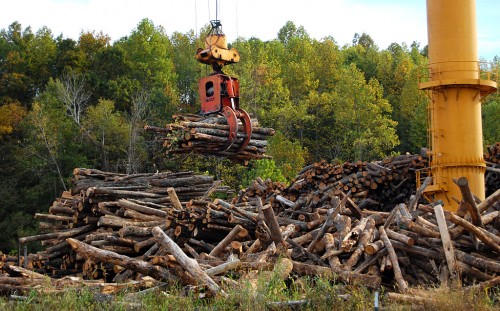 We watched the operator scale the big column, get into his “office” and set the crane in motion. He dropped the grapple gently over a stack of logs on a semi, then gradually caused its fingers to wrap around them.
We watched the operator scale the big column, get into his “office” and set the crane in motion. He dropped the grapple gently over a stack of logs on a semi, then gradually caused its fingers to wrap around them.
When he was satisfied he had them in his grip, he lifted them off the truck, usually without dropping any, and gave them a ride to the big stack. It was like playing with Giant Pick-Up Sticks. He made it look so easy that Mark commented, “That looks like fun. I could do that all day long.”
Tim Hart, mill manager
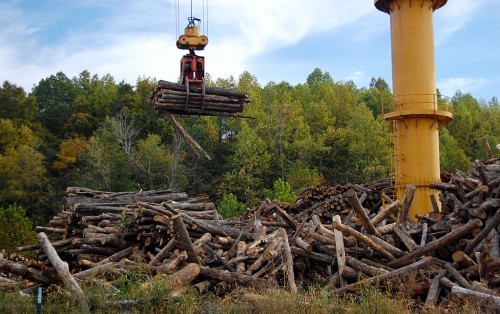 After shooting these frames, I walked back across the road where the wood chips were piled. “What are you doing?” Tim Hart, mill manager for Forbes, asked. His tone was curious, not confrontational. After identifying myself and my mission, we had a friendly and informative chat.
After shooting these frames, I walked back across the road where the wood chips were piled. “What are you doing?” Tim Hart, mill manager for Forbes, asked. His tone was curious, not confrontational. After identifying myself and my mission, we had a friendly and informative chat.
Missouri Fibre takes scrap wood not suitable for lumber and turns it into wood chips and mulch. The chipper is set up to handle wood up to 24 inches thick. “We can actually handle a little larger, but we tell the suppliers 24 inches, knowing that they’ll send us some slightly larger.” This is the big brother to the wood chipper you might see on your street devouring small tree branches.
The crane we were watchng was erected in 2002 at a cost of two million dollars. The operator is sitting about 90 feet above the ground and the boom is about the same length.
Mill ships about 250,000 tons a year
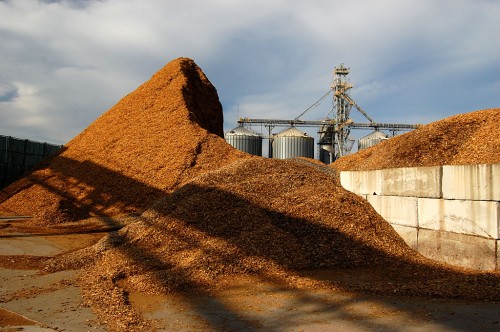 The wood is a mixture of everything cut locally, but it’s mostly hardwood – oak, cherry, dogwood and ash. Pieces that are too large to run through the chipper are used as firewood.
The wood is a mixture of everything cut locally, but it’s mostly hardwood – oak, cherry, dogwood and ash. Pieces that are too large to run through the chipper are used as firewood.
Tim said the mill ships out 200 to 250-thousand tons of material a year, mostly by barge. “The [2011] flood slowed us down. We couldn’t ship by barge, so we had to use trucks.”
Ready for more logs
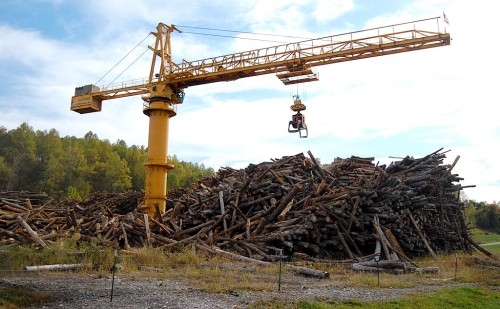 Tim said the Cape mill is the largest the corporation’s half-dozen scattered throughout the state. The demand for newsprint and office paper is down, he said, but an increase in the amount of biofuel needed has helped to offset the drop. The mill employs about six workers for its five-day-a week operation.
Tim said the Cape mill is the largest the corporation’s half-dozen scattered throughout the state. The demand for newsprint and office paper is down, he said, but an increase in the amount of biofuel needed has helped to offset the drop. The mill employs about six workers for its five-day-a week operation.
It’s pretty amazing what you can run into if you aren’t afraid to go down unfamiliar roads and talk to strangers.

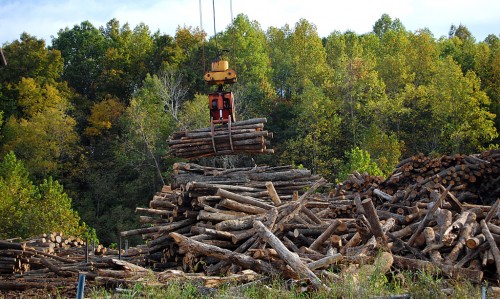
Thanks, Ken. I found this an interesting operation. Forty years ago when I taught and coached during the summer vacation, I would cut timber. General Cable had a reclaimation plant and we would haul hardwoods into their yard. They had to be a certain size which looks about like the wood in your photos. The wood was fed a log at a time into the furnace. I believe it had something to do with the separation of the wire insulation from the copper. I guess the operation is no longer economical as the plant sits empty today.
I still enjoy cutting fire wood but now it is just to clean up fallen trees and brush. Although I announce I am going to the woods to work today, I generally last only two or three hours a day now. I take a lawn chair to watch the brush burn!
This is very interesting! I lived in Cape for over 30 years and even worked in Illmo at Krogers for a while but I never got out to what is now the port areabut I want to do just that the next time I get to cape which is on the average of once a year
Joe Whitright “45”
Did you run across a Girardeau Stevedors while at the port…Lanny Koch, my husband’s brother & his family (wife, & six boys, 2 of their wives & at present 2 grandson in high school work 1/2 days & weekends) have an interesting operation at the port as well. They built the business from the ground up from the beginnings of the Port! Hard working family putting in long hours…so proud of what they’ve achieved working together!
I didn’t poke around much at the Port. Mark and Robin had to get back to St. Louis and it was getting late afternoon.
I’m going to go back for another look. Where is their business and what do they do?
I don’t know if you read in between the lines, but the biofuel Tim hart is referring to is ethyl alcohol (ethanol) production from plant fiber. This industry is new and picking up. It is a better source for fermentation stocks than food products (corn) since it doesn’t compete with humans and animals in the food chain.
Motive Rail at the port also has an interesting story.
No, I didn’t read between the lines. I was thinking of using the wood chips as fuel that is burned, much like the cement plant uses shredded tires and other waste as fuel.
I was surprised at the number of small switch engines I saw at the port.
I’m definitely going back. I kept waiting for someone to throw me out, but nobody but Tim Hart gave me a second look, and he was extremely helpful. It’s refreshing to talk with someone who doesn’t “have to clear it with corporate.”
The next time you make it out to the Port go past the wood chips plant and turn right and go all the way up the hill before turning around to come back down….an amazing view…old quarry on the right…the river and the bridge. MB